A Workflow for Uncertainty Assessment in Elemental Analysis of Archaeological Ceramics: A Case Study of Neolithic Coarse Pottery from Eastern Siberia
Abstract
:1. Introduction
2. Research Aim
3. Materials and Methods
3.1. Object of Study
3.2. Description and Preliminary Preparation of Ceramic Samples for Uncertainty Assessment
3.3. Methods
- WDXRFWDXRF measurements were performed with a wavelength-dispersive XRF spectrometer S8 Tiger (Bruker AXS, Karlsruhe, Germany) equipped with the Rh anode X-ray tube, and an 8 mm collimator mask for the measurement of small samples. The powdered samples weighing 150 mg were dried at 950 °C for 4 h and the loss on ignition (LOI) values were determined. Then, a mixture of calcined sample weighing 110 mg, 1.1 g of extra-pure lithium metaborate and 7 drops of 40 mg/mL LiBr solution was fused in a platinum crucible in the electric furnace TheOX (Claisse, Québec, QC, Canada) at 1050 °C for 19 min to prepare glass disks with a diameter of 10–12 mm [31]. This technique was previously successfully applied to the elemental XRF analysis of bottom sediments and ancient ceramics [14,32]. Certified reference materials (CRMs) were used to construct calibration curves and control the accuracy, namely silts (BIL-1, BIL-2, SGH-1, SGH-3, SGH-5), loose sediments (SGHM-1, SGHM-2, SGHM-3, SGHM-4), aleurolite (SA-1), clays, slits, and ooze (SDO-1, SDO-2, SDO-8, SDO-9), provided by the Vinogradov Institute of Geochemistry and Research Institute of Applied Physics from Russia; CRMs of sedimentary rocks (JSD-1, JSD-2, JSD-3, JLK-1) were provided by the Geological Survey of Japan; CRMs CH-1 (marine sediment, GeoPT-10), UoK Loess (Köln loess, GeoPT-13), SdAR-1 (modified river sediment, GeoPT-31), and DBC-1 (clay, GeoPT-33) were provided by the International Association of Geoanalysts;
- ICP-MSICP-MS analysis was performed with an Agilent 7500ce quadrupole mass spectrometer (Agilent Technologies Inc., USA). The preparation of the sample was carried out as follows: 100 mg of powdered and dried sample was carefully mixed with 400 mg of lithium metaborate in a 30 mL glassy carbon crucible. The samples were fused in a muffle furnace at 1100 °C for 7 min. After the bead cooled, 3 mL of HF and 1 mL of HNO3 were added and allowed to stand overnight at room temperature. The next day, the mixture was evaporated to dryness. Then, 30 mL of 4 vol.% HNO3 was added to the residue. The solution was stirred with a magnetic stirrer for the complete dissolution of the bead. The resulting solution was filtered into 100 mL volumetric flasks and diluted to volume with 4 vol.% HNO3. Then, 0.5 mL aliquot was transferred to a 15 mL polypropylene test tube and diluted with 9.5 mL of 2 vol.% HNO3. The final dilution factor was 20,000. Before analysis, 100 µL of In solution (10 ng/mL) and 100 µL of Bi solution (10 ng/mL) were added to 10 mL of a sample in accordance with internal standards. Calibration curves were constructed, and accuracy testing was carried out using the geological reference materials of sedimentary, ultramafic, and mafic rocks. This technique was previously successfully applied for the elemental analysis of rocks and sediments [33,34];
- Scanning electron microscopy (SEM-EDS)The scanning electron microscope MIRA 3 LMH (Tescan, Czech Republic) was used for the investigation of mineral composition. Epoxy-mounted and polished samples were coated with a thin carbon film (thickness 20–30 nm) to remove any electric charge, applying the Q150R ES vacuum coater (Quorum Technologies, Lewes, UK). The elemental composition of the base matrix and inclusion mineral phases was determined by the AztecLive Advanced Ultim Max 40 microanalysis system with a nitrogen-free energy dispersive spectrometer (EDS) (Oxford Instruments Analytical Ltd., High Wycombe, UK) that allows the simultaneous recording of the intensity of the X-ray spectrum of all elements. SEM-EDS analysis was performed at an acceleration voltage of 20 kV, a beam intensity pulse of 18.50 pulse, an absorbed current of 1.6 nA, and beam diameter of 33 nm;
- µXRF analysisMicro-X-ray fluorescence analysis performed by a Tornado M4+ spectrometer (Bruker Nano, Berlin, Germany) was used for elemental mapping. A spectrometer was equipped with an X-ray tube with Rh anode and polycapillary focusing optics. Area mapping was carried out with 20 µm pixel size and 50 ms dwell time; the sample chamber was kept at 25 mbar vacuum. Mapping was carried out in two sequential runs (so-called frames); the final map is a sum of two frames. The samples were epoxy-mounted and polished prior to the analysis.
4. Results and Discussion
4.1. An Experimental Workflow for Estimating the Uncertainties
4.2. Evaluation of Uncertainties Introduced by WDXRF and ICP-MS Analysis
4.3. Evaluation of Uncertainty Introduced by Sampling (Heterogeneity)
4.4. The Heterogeneity Characterization of Ceramic Cross-Section by SEM and µXRF
4.5. Theoretical Modeling of Sampling Error
5. Conclusions
Supplementary Materials
Author Contributions
Funding
Data Availability Statement
Acknowledgments
Conflicts of Interest
References
- Hunt, A. (Ed.) The Oxford Handbook of Archaeological Ceramic Analysis; Oxford University Press: New York, NY, USA, 2016. [Google Scholar] [CrossRef]
- Kazakis, N.A.; Tsirliganis, N.C. Provenance of ceramics: Methods and Practices. In Best Practices of Geoinformatic Technologies for the Mapping of Archaeolandscapes; Sarris, A., Ed.; Archaeopress Publishing Ltd.: Oxford, UK, 2015; pp. 241–252. [Google Scholar]
- Tite, M.S. Ceramic production, provenance and use—A review. Archaeometry 2008, 50, 216–231. [Google Scholar] [CrossRef]
- Speakman, R.J.; Glascock, M.D. Acknowledging fifty years of neutron activation analysis in archaeology. Archaeometry 2007, 49, 179–183. [Google Scholar] [CrossRef]
- Speakman, R.J.; Little, N.C.; Creel, D.; Miller, M.R.; Iñañez, J.G. Sourcing ceramics with portable XRF spectrometers? A comparison with INAA using Mimbres pottery from the American Southwest. J. Archaeol. Sci. 2011, 38, 3483–3496. [Google Scholar] [CrossRef]
- Sterba, J.H. A workflow for neutron activation analysis of archaeological ceramics at the Atominstitut in Vienna, Austria. J. Radioanal. Nucl. Chem. 2018, 316, 753–759. [Google Scholar] [CrossRef] [PubMed]
- Hein, A.; Tsolakidou, A.; Iliopoulos, I.; Mommsen, H.; Buxeda i Garrigós, J.; Montana, G.; Kilikoglou, V. Standardisation of elemental analytical techniques applied to provenance studies of archaeological ceramics: An inter laboratory calibration study. Analyst 2002, 127, 542–553. [Google Scholar] [CrossRef] [PubMed]
- Tsolakidou, A.; Buxeda i Garrigós, J.; Kilikoglou, V. Assessment of dissolution techniques for the analysis of ceramic samples by plasma spectrometry. Anal. Chim. Acta 2002, 474, 177–188. [Google Scholar] [CrossRef]
- Ferri, T.Z.; Rončević, S.; Vrkljan, G.L.; Konestra, A. Post-depositional alterations of terrestrial and marine finds of Roman ceramics from Crikvenica production centre (NE Adriatic, Croatia)—A contribution towards chemometric classification. J. Cult. Herit. 2020, 43, 12–25. [Google Scholar] [CrossRef]
- De Vleeschouwer, F.; Renson, V.; Claeys, P.; Nys, K.; Bindler, R. Quantitative WD-XRF calibration for small ceramic samples and their source material. Geoarchaeology 2011, 26, 440–450. [Google Scholar] [CrossRef]
- Georgakopoulou, M.; Hein, A.; Müller, N.S.; Kiriatzi, E. Development and calibration of a WDXRF routine applied to provenance studies on archaeological ceramics: WDXRF routine for archaeological ceramics analysis. X-Ray Spectrom. 2017, 46, 186–199. [Google Scholar] [CrossRef]
- Ichikawa, S.; Matsumoto, T.; Nakamura, T.; Kurisaki, T. Provenance determination of prehistorical pottery from Oshima Island belonging to Izu islands (Tokyo, Japan) using X-ray fluorescence spectrometry. X-Ray Spectrom. 2019, 48, 107–125. [Google Scholar] [CrossRef]
- Ichikawa, S.; Matsumoto, T.; Nakamura, T.; Kurisaki, T. Provenance identification of ancient pottery from Hachijojima Island, part of Izu Islands (Tokyo, Japan), using X-ray fluorescence spectrometry. X-Ray Spectrom. 2020, 49, 515–532. [Google Scholar] [CrossRef]
- Pashkova, G.V.; Mukhamedova, M.M.; Chubarov, V.M.; Maltsev, A.S.; Amosova, A.A.; Demonterova, E.I.; Mikheeva, E.A.; Shergin, D.L.; Pellinen, V.A.; Teten’kin, A.V. Comparative analysis of X-ray fluorescence methods for elemental composition determination of the archaeological ceramics from low sample quantity. Anal. Control 2021, 25, 20–33. [Google Scholar] [CrossRef]
- García-Heras, M.; Fernández-Ruiz, R.; Tornero, J.D. Analysis of archaeological ceramics by TXRF and contrasted with NAA. J. Archaeol. Sci. 1997, 24, 1003–1014. [Google Scholar] [CrossRef]
- Fernández-Ruiz, R.; García-Heras, M. Study of Archaeological Ceramics by Total-Reflection X-Ray Fluorescence Spectrometry: Semi-Quantitative Approach. Spectrochim. Acta Part B 2007, 62, 1123–1129. [Google Scholar] [CrossRef]
- Maltsev, A.S.; Pashkova, G.V.; Fernández-Ruiz, R.; Demonterova, E.I.; Shuliumova, A.N.; Umarova, N.N.; Shergin, D.L.; Mukhamedova, M.M.; Chubarov, V.M.; Mikheeva, E.A. Characterization of archaeological ceramics from eastern Siberia by total-reflection X-ray fluorescence spectrometry and principal component analysis. Spectrochim. Acta Part B 2021, 175, 106012. [Google Scholar] [CrossRef]
- Maltsev, A.S.; Umarova, N.N.; Pashkova, G.V.; Mukhamedova, M.M.; Shergin, D.L.; Panchuk, V.V.; Kirsanov, D.O.; Demonterova, E.I. Combination of total-reflection X-Ray fluorescence method and chemometric techniques for Provenance Study of Archaeological Ceramics. Molecules 2023, 28, 1099. [Google Scholar] [CrossRef]
- Boulanger, M.T.; Fehrenbach, S.S.; Glascock, M.D. Experimental evaluation of sample-extraction methods and the potential for contamination in ceramic specimens. Archaeometry 2013, 55, 880–892. [Google Scholar] [CrossRef]
- Bishop, R.L.; Canouts, V.; Crown, P.L.; de Atley, S.P. Sensitivity, Precision, and Accuracy: Their Roles in Ceramic Compositional Data Bases. Am. Antiq. 1990, 55, 537–546. [Google Scholar] [CrossRef]
- Marks, R.H. Evaluating Data: Uncertainty in Ceramic Analysis. In The Oxford Handbook of Archaeological Ceramic Analysis; Hunt, A., Ed.; Oxford University Press: New York, NY, USA, 2016; pp. 47–57. [Google Scholar] [CrossRef]
- Hein, A.; Kilikoglou, V. Compositional variability of archaeological ceramics in the eastern Mediterranean and implications for the design of provenance studies. J. Archaeol. Sci. Rep. 2017, 16, 564–572. [Google Scholar] [CrossRef]
- Potts, P.J. A Handbook of Silicate Rock Analysis; Springer: Dordrecht, The Netherlands, 2013. [Google Scholar] [CrossRef]
- Stanley, C.R. Numerical transformation of geochemical data: 2. Stabilizing measurement error to facilitate data interpretation. Geochem. Explor. Environ. Anal. 2006, 6, 79–96. [Google Scholar] [CrossRef]
- Stanley, C.R. Estimating sampling errors for major and trace elements in geological materials using a propagation of variance approach. Explor. Environ. Anal. 2003, 3, 169–178. [Google Scholar] [CrossRef]
- Pashkova, G.V.; Demonterova, E.I.; Chubarov, V.M.; Kaneva, E.V.; Shergin, D.L.; Maltsev, A.S.; Amosova, A.A.; Mukhamedova, M.M.; Mikheeva, E.A. Characteristic of the mineral and elemental composition of the Popovsky Lug station (Upper Lena) neolithic ceramics. In Proceedings of the Interdisciplinary Archaeological Research of the Ancient Cultures of the Yenisei Siberia and Adjacent Territories, Krasnoyarsk, Russia, 20–21 October 2020; pp. 45–54. (In Russian). [Google Scholar]
- Vetrov, V.M. Stratigraphy of the Popovsky Lug site. On the question of the origin of ceramic production in the Upper Lena. In Proceedings of the Sociogenesis of North Asia: Past, Present, Future, Irkutsk, Russia, 12–15 November 2003; pp. 49–53. (In Russian). [Google Scholar]
- Shergin, D.L. Posol’sky-type ceramics of the Upper Lena basin (based on the data of Popovsky Lug and Makarovo I sites). Rep. Lab. Anc. Technol. 2023, 19, 8–32. (In Russian) [Google Scholar]
- Berdnikova, N.E. Ust-Belsky ceramic layer: (to the formulation of the problem). In Proceedings of the Quaternary Geology and Primitive Archeology of Southern Siberia Volume II, Ulan-Ude, Russia, 30 May–June 1986; pp. 36–39. (In Russian). [Google Scholar]
- Savelyev, N.A. The Neolithic Age of the South of Central Siberia (History of Major Ideas and Modern State of the Problem) [Neolit Yuga Sredney Sibiri: (Istoriya Osnovnykh Idey i Sovremennoye Sostoyaniye Problemy)]. The Dissertation of the Candidate of History, Novosibirsk, Russia, 1989; 302p. (In Russian). [Google Scholar]
- Amosova, A.A.; Panteeva, S.V.; Chubarov, V.M.; Finkelshtein, A.L. Determination of major elements by wavelength-dispersive X-ray fluorescence spectrometry and trace elements by inductively coupled plasma mass spectrometry in igneous rocks from the same fused sample (110 mg). Spectrochim. Acta Part B 2016, 122, 62–68. [Google Scholar] [CrossRef]
- Amosova, A.A.; Chubarov, V.M.; Pashkova, G.V.; Finkelshtein, A.L.; Bezrukova, E.V. Wavelength dispersive X-ray fluorescence determination of major oxides in bottom and peat sediments for paleoclimatic studies. Appl. Radiat. Isot. 2019, 144, 118–123. [Google Scholar] [CrossRef]
- Pashkova, G.V.; Panteeva, S.V.; Ukhova, N.N.; Chubarov, V.M.; Finkelshtein, A.L.; Ivanov, A.V.; Asavin, A.M. Major and trace elements in meimechites—Rarely occurring volcanic rocks: Developing optimal analytical strategy. Geochem. Explor. Environ. Anal. 2019, 19, 233–243. [Google Scholar] [CrossRef]
- Chubarov, V.M.; Pashkova, G.V.; Panteeva, S.V.; Amosova, A.A. Multielement analysis of continental and lacustrine ferromanganese nodules by WDXRF, TXRF and ICP MS methods: Intercomparison study and accuracy assessment. Appl. Radiat. Isot. 2021, 178, 109981. [Google Scholar] [CrossRef]
- Shakhashiro, A.; Trinkl, A.; Törvenyi, A.; Zeiller, E.; Benesch, T.; Sansone, U. Report on the IAEA-CU-2006-06 Proficiency Test: Determination of Major, Minor and Trace Elements in Ancient Chinese Ceramic; International Atomic Energy Agency: Seibersdorf, Austria, 2006. [Google Scholar]
- Béarat, H.; Dufournier, D. Quelques expériences sur la fixation du phosphore par les céramiques. Revue d'Archéométrie 1994, 18, 65–73. [Google Scholar] [CrossRef]
- López, M.A. Alteraciones de Superficies y Pastas de Cerámica Arqueológica. Un Caso de Estudio en Quebrada de Humahuaca. Jujuy, República Argentina. Bol. del Lab. de Petrol. y Conserv. Ceram. 2008, 1, 1–12. (In Spanish) [Google Scholar]
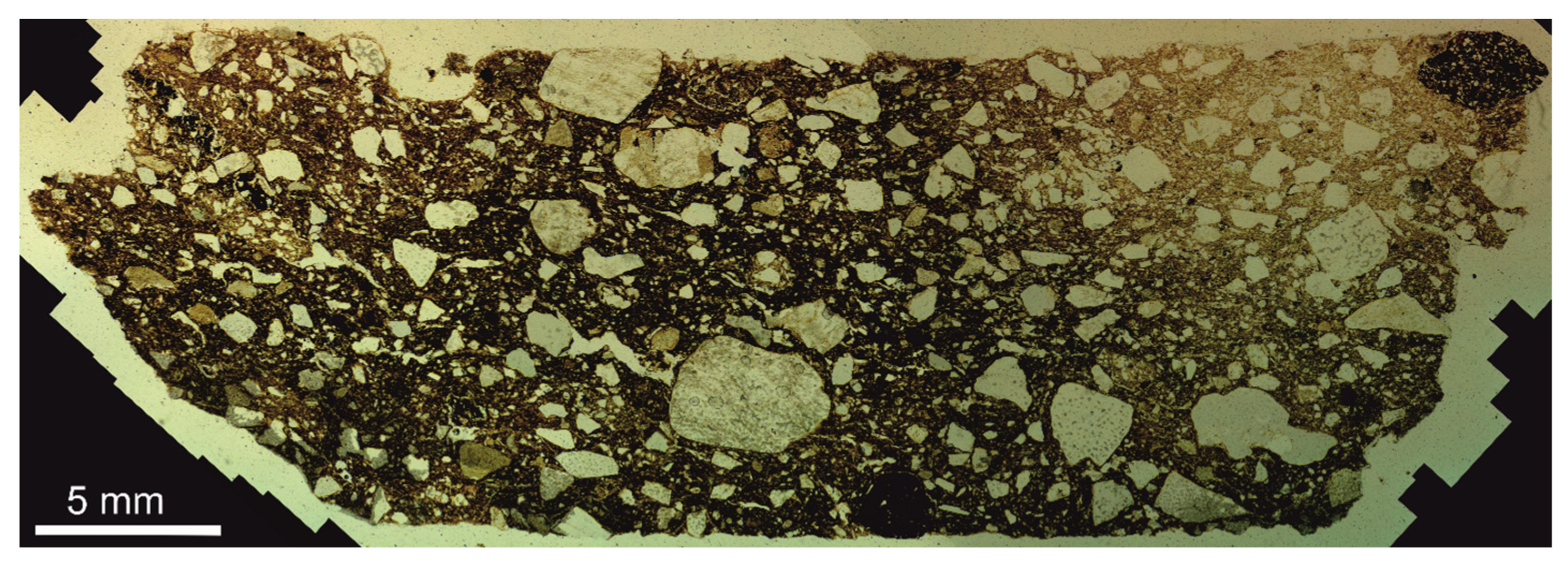


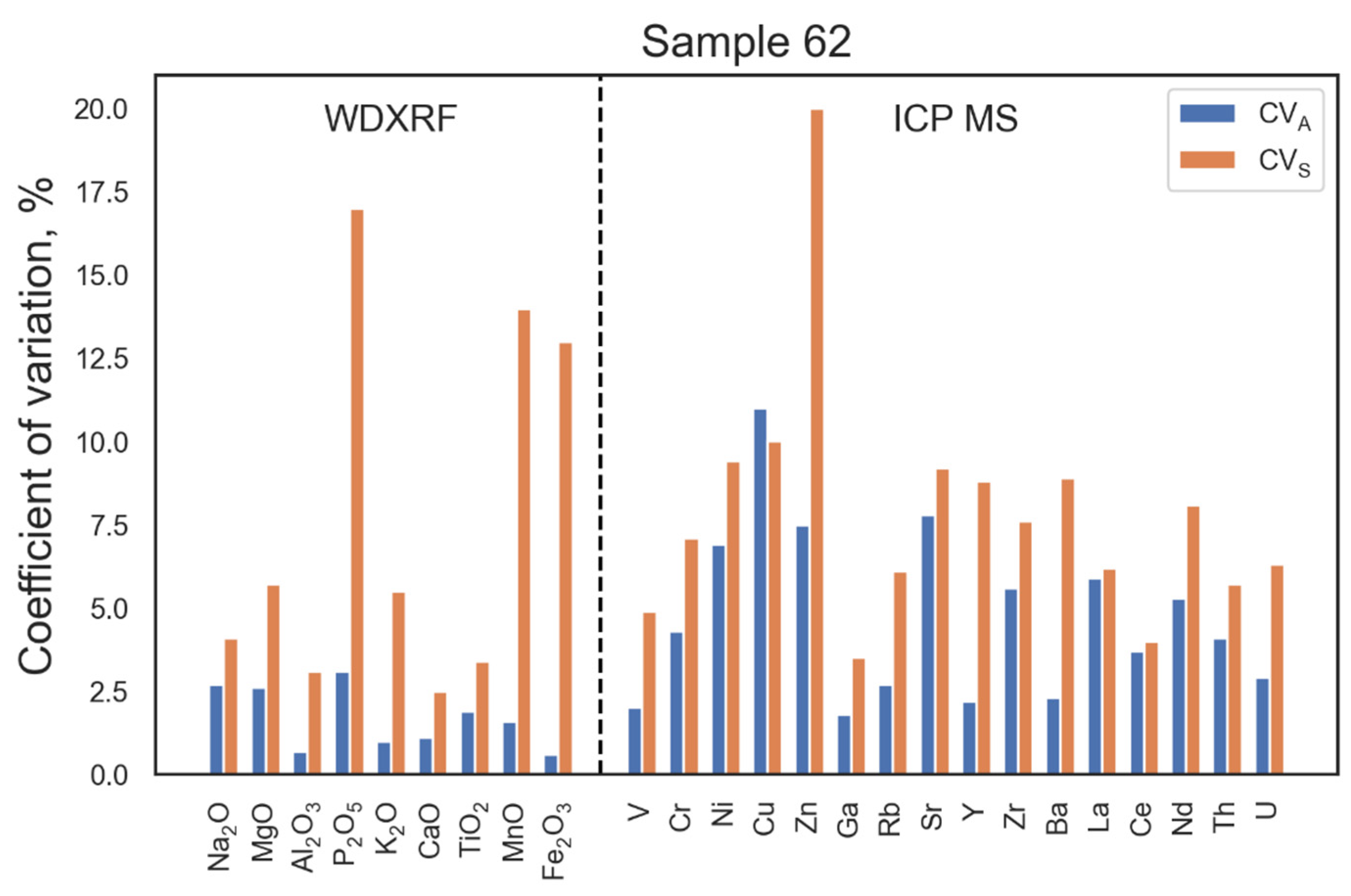
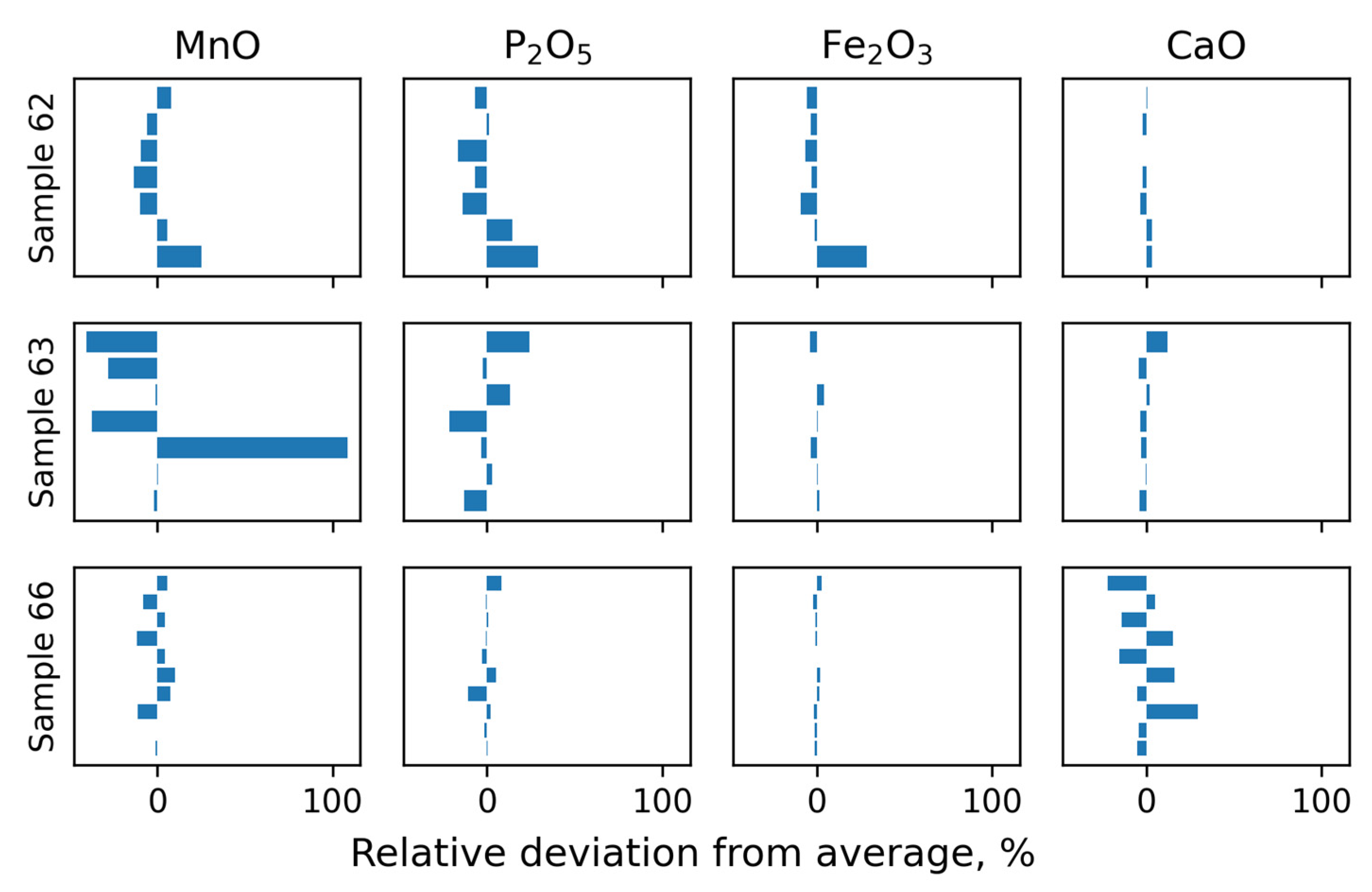


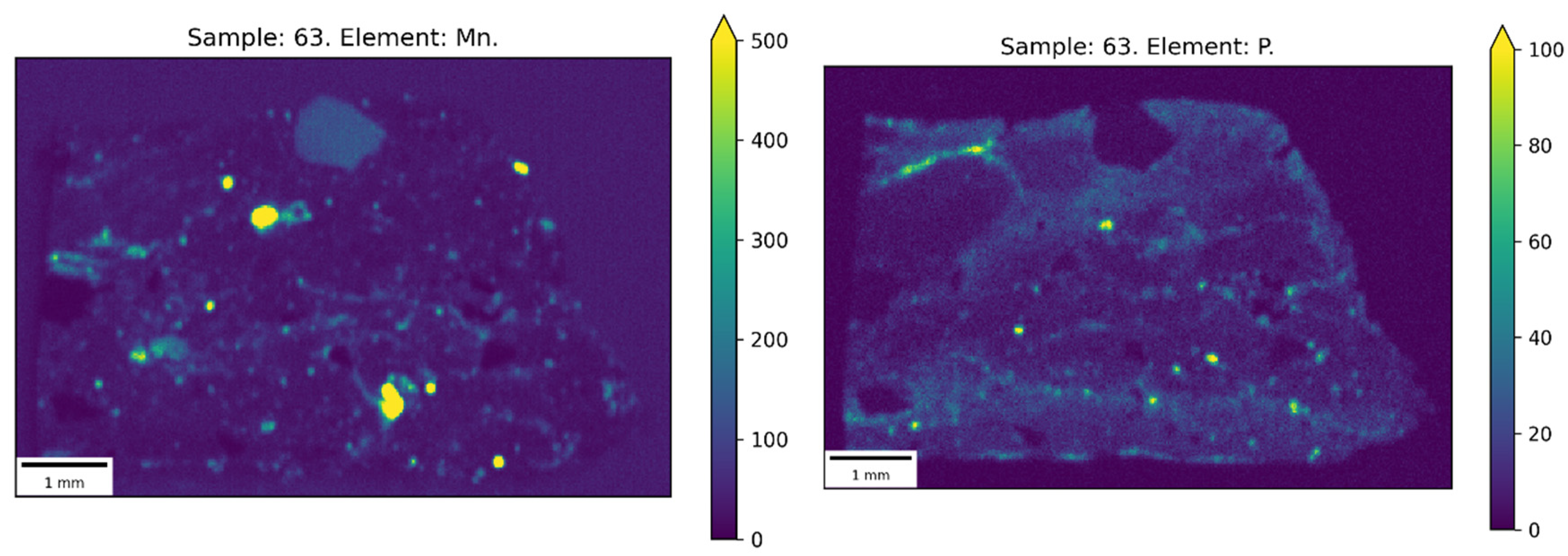
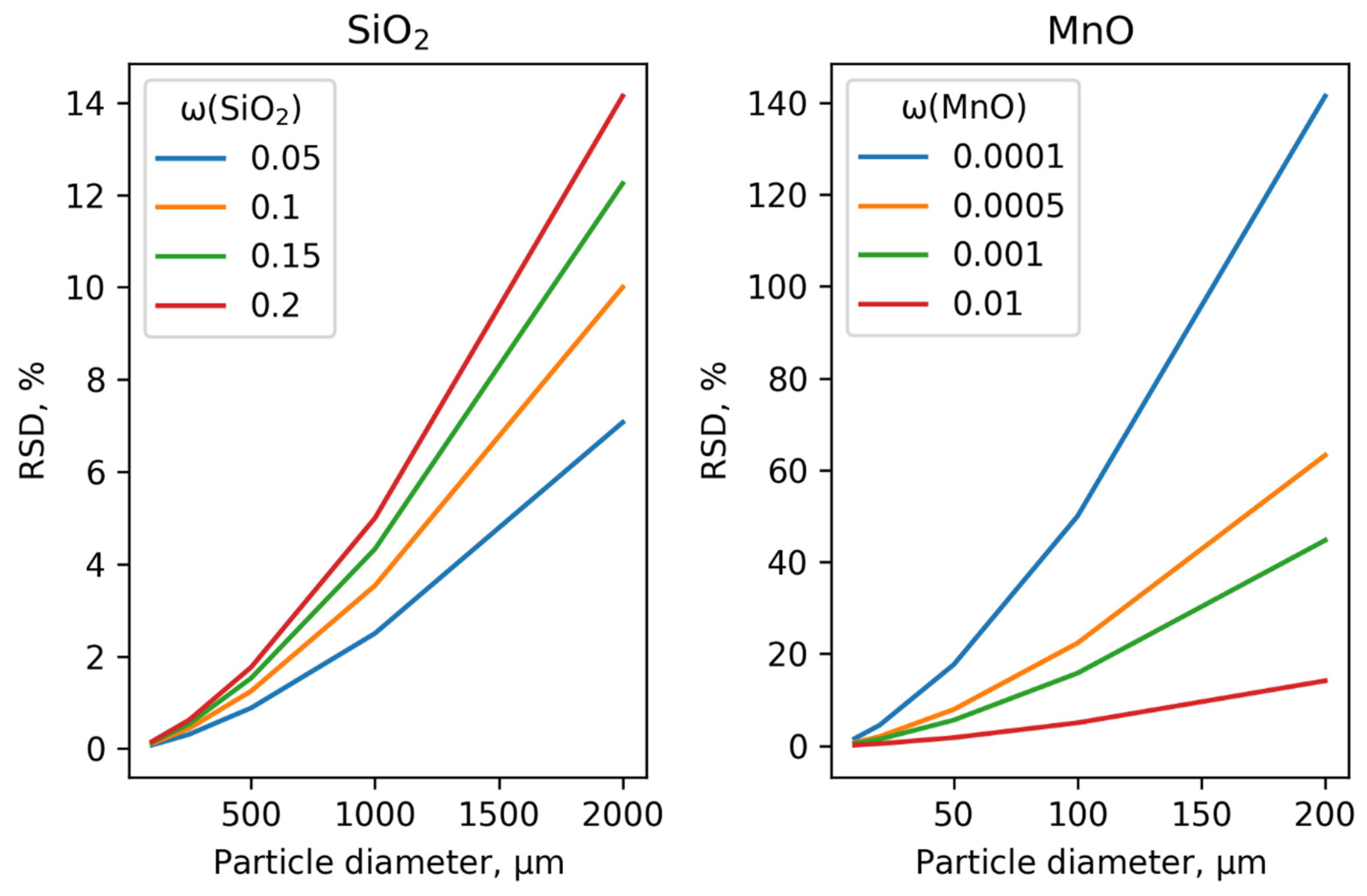
| Compound | WDXRF | ICP-MS | ||||
|---|---|---|---|---|---|---|
| CVmeas | CVprep | CVA | CVmeas | CVprep | CVA | |
| Na2O | 2.0 | 1.8 | 2.7 | 1.8 | 1.3 | 2.2 |
| MgO | 2.0 | 1.7 | 2.6 | 0.62 | 3.0 | 3.0 |
| Al2O3 | 0.47 | 0.47 | 0.66 | 0.38 | 1.5 | 1.6 |
| SiO2 | 0.11 | 0.56 | 0.57 | - | - | - |
| P2O5 | 2.7 | 1.5 | 3.1 | 1.0 | 2.1 | 2.3 |
| K2O | 0.60 | 0.78 | 1.0 | 0.64 | 1.1 | 1.3 |
| CaO | 0.54 | 0.90 | 1.1 | 0.79 | 6.8 | 6.9 |
| TiO2 | 1.7 | 0.89 | 1.9 | 0.47 | 1.2 | 1.3 |
| MnO | 1.0 | 1.2 | 1.6 | 0.58 | 3.0 | 3.0 |
| Fe2O3 | 0.18 | 0.62 | 0.64 | 0.42 | 1.4 | 1.4 |
| V | - | - | - | 0.30 | 1.9 | 2.0 |
| Cr | - | - | - | 0.71 | 4.3 | 4.3 |
| Ni | - | - | - | 2.5 | 6.4 | 6.9 |
| Cu | - | - | - | 6.1 | 8.6 | 11 |
| Zn | - | - | - | 0.41 | 7.5 | 7.5 |
| Ga | - | - | - | 0.54 | 1.7 | 1.8 |
| Rb | - | - | - | 0.32 | 2.7 | 2.7 |
| Sr | 7.9 | 7.6 | 11 | 0.35 | 7.8 | 7.8 |
| Y | - | - | - | 0.38 | 2.2 | 2.2 |
| Zr | 2.2 | 5.8 | 6.2 | 0.20 | 5.6 | 5.6 |
| Ba | 6.0 | 6.5 | 8.8 | 0.33 | 2.3 | 2.3 |
| La | - | - | - | 0.44 | 5.9 | 5.9 |
| Ce | - | - | - | 0.38 | 3.6 | 3.7 |
| Nd | - | - | - | 0.83 | 5.2 | 5.3 |
| Th | - | - | - | 1.0 | 4.0 | 4.1 |
| U | - | - | - | 0.78 | 2.7 | 2.9 |
| Compound | No. 62 | No. 63 | No. 66 | |||
|---|---|---|---|---|---|---|
| WDXRF | ICP-MS | WDXRF | ICP-MS | WDXRF | ICP-MS | |
| Na2O | 4.1 | 3.2 | 3.1 | 3.8 | 14 | 4.8 |
| MgO | 5.7 | 4.4 | 1.5 | 4.0 | 1.9 | 1.9 |
| Al2O3 | 3.1 | 3.5 | 3.9 | 3.5 | 0.7 | 1.8 |
| SiO2 | 1.4 | - | 1.9 | - | 0.52 | - |
| P2O5 | 17 | 14 | 15 | 16 | 5.0 | 7.4 |
| K2O | 5.5 | 6.2 | 4.7 | 4.7 | 1.4 | 2.7 |
| CaO | 2.5 | 4.2 | 5.9 | 9.8 | 16 | 18 |
| TiO2 | 3.4 | 4.2 | 2.9 | 2.4 | 1.1 | 2.3 |
| MnO | 14 | 14 | 51 | 47 | 7.9 | 10 |
| Fe2O3 | 13 | 14 | 2.8 | 3.2 | 1.6 | 2.7 |
| V | - | 4.9 | - | 4.7 | - | 2.6 |
| Cr | - | 7.1 | - | 2.2 | - | 4.7 |
| Ni | - | 9.4 | - | 6.8 | - | 7.7 |
| Cu | - | 10 | - | 12 | - | 5.5 |
| Zn | - | 20 | - | 12 | - | 9.3 |
| Ga | - | 3.5 | - | 4.5 | - | 2.0 |
| Rb | - | 6.1 | - | 6.7 | - | 2.2 |
| Sr | 7.9 | 9.2 | 6.7 | 7.9 | 12 | 8.4 |
| Y | - | 8.8 | - | 2.5 | 2.3 | |
| Zr | 8.6 | 7.6 | 7.2 | 6.3 | 4.7 | 2.7 |
| Ba | 11 | 8.9 | 7.4 | 8.1 | 5.8 | 3.3 |
| La | - | 6.2 | - | 2.7 | - | 2.3 |
| Ce | - | 4.0 | - | 5.7 | - | 2.1 |
| Nd | - | 8.1 | - | 3.6 | - | 3.7 |
| Th | - | 5.7 | - | 2.6 | - | 1.7 |
| U | - | 6.3 | - | 5.6 | - | 3.9 |
Disclaimer/Publisher’s Note: The statements, opinions and data contained in all publications are solely those of the individual author(s) and contributor(s) and not of MDPI and/or the editor(s). MDPI and/or the editor(s) disclaim responsibility for any injury to people or property resulting from any ideas, methods, instructions or products referred to in the content. |
© 2023 by the authors. Licensee MDPI, Basel, Switzerland. This article is an open access article distributed under the terms and conditions of the Creative Commons Attribution (CC BY) license (https://creativecommons.org/licenses/by/4.0/).
Share and Cite
Pashkova, G.V.; Statkus, M.A.; Mukhamedova, M.M.; Finkelshtein, A.L.; Abdrashitova, I.V.; Belozerova, O.Y.; Chubarov, V.M.; Amosova, A.A.; Maltsev, A.S.; Demonterova, E.I.; et al. A Workflow for Uncertainty Assessment in Elemental Analysis of Archaeological Ceramics: A Case Study of Neolithic Coarse Pottery from Eastern Siberia. Heritage 2023, 6, 4434-4450. https://doi.org/10.3390/heritage6050234
Pashkova GV, Statkus MA, Mukhamedova MM, Finkelshtein AL, Abdrashitova IV, Belozerova OY, Chubarov VM, Amosova AA, Maltsev AS, Demonterova EI, et al. A Workflow for Uncertainty Assessment in Elemental Analysis of Archaeological Ceramics: A Case Study of Neolithic Coarse Pottery from Eastern Siberia. Heritage. 2023; 6(5):4434-4450. https://doi.org/10.3390/heritage6050234
Chicago/Turabian StylePashkova, Galina V., Mikhail A. Statkus, Maria M. Mukhamedova, Alexander L. Finkelshtein, Irina V. Abdrashitova, Olga Yu. Belozerova, Victor M. Chubarov, Alena A. Amosova, Artem S. Maltsev, Elena I. Demonterova, and et al. 2023. "A Workflow for Uncertainty Assessment in Elemental Analysis of Archaeological Ceramics: A Case Study of Neolithic Coarse Pottery from Eastern Siberia" Heritage 6, no. 5: 4434-4450. https://doi.org/10.3390/heritage6050234
APA StylePashkova, G. V., Statkus, M. A., Mukhamedova, M. M., Finkelshtein, A. L., Abdrashitova, I. V., Belozerova, O. Y., Chubarov, V. M., Amosova, A. A., Maltsev, A. S., Demonterova, E. I., & Shergin, D. L. (2023). A Workflow for Uncertainty Assessment in Elemental Analysis of Archaeological Ceramics: A Case Study of Neolithic Coarse Pottery from Eastern Siberia. Heritage, 6(5), 4434-4450. https://doi.org/10.3390/heritage6050234






